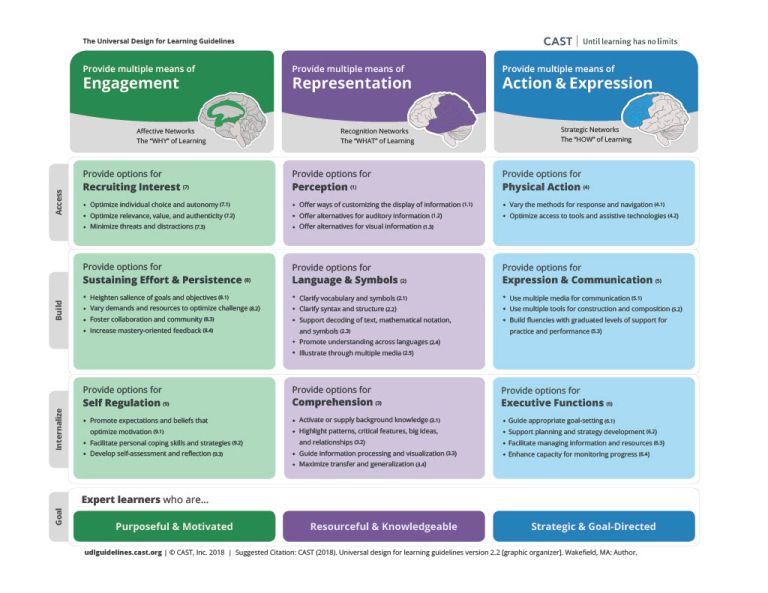Universal Design for Learning
The principles of Universal Design for Learning (UDL; Center for Applied Special Technology, 2018) underpin inclusionED’s work. The UDL framework is a proactive approach to supporting students with disability and diverse learning needs to access the approved curriculum. UDL focusses on eliminating barriers through initial designs that consider the needs of diverse people, rather than overcoming barriers later through individual adaptation (Rose et al., 2006; Doabler et al., 2015; Novak & Thibodeau, 2016).
In this video Dr Matt Capp talks to Professor Suzanne Carrington about the 3 principles of UDL.
Duration 05:49
The 3 principles of UDL.
The principles of UDL
Rather than a list of pedagogical strategies, UDL is a framework for thinking about the planning, teaching and assessments cycle.
The UDL framework
- considers and plans to meet the needs of diverse people
- eliminates barriers through the initial design and planning
- guides educators to design and implement instruction in a flexible manner
- improves the learning process for all students.
The philosophy of UDL is based on 3 broad principles, underpinned by 9 guidelines and 31 checkpoints*, which are divided into three layers: access, build, and internalise.
*Guidelines and checkpoints are more targeted and specific ways of implementing a broad principle of the UDL framework.

CAST (2018). Universal design for learning guidelines version 2.2 [graphic organizer]. Wakefield, MA: Author.
| Principle 1: Provide multiple means of Engagement. |
During the planning, teaching, and assessment cycle ask yourself “am I engaging my students in the learning process in multiple ways?” There are multiple ways of engaging students. No single option works for all students and you can provide students with a range of engaging learning materials. |
| Principle 2: Provide multiple means of Representation. |
During the planning, teaching, and assessment cycle ask yourself “am I presenting information and content to my students in multiple ways, through multiple senses?” There are multiple ways of representing content: auditory such as podcasts, the use of text-to speech software to represent written content via auditory means, visual presentations can be static or moving (e.g. pictures, graphics, videos). No single option works for all students and providing options is necessary. |
| Principle 3: Provide multiple means of Action and Expression |
During the planning, teaching, and assessment cycle ask yourself “Am I giving learners multiple ways to participate and engage with learning activities?” The ways in which your students participate and express what they know will differ between students, and providing options is necessary. |
UDL and assessment
A UDL approach to assessment incorporates recurring and flexible formative assessment throughout instruction to provide ongoing, actionable feedback to educators and students before failure takes place, when acting can make a real difference for all (Rose et al., 2018).
UDL and planning.
Listen as Dr. Matt Capp describes his experience of working with teachers to use UDL in their planning. Duration: 01:56
In this video, Dr. Matt Capp explains the evidence supporting the application of UDL.
Duration: 01:44
The application of UDL.
How does Universal Design for Learning differ from Differentiated Instruction?
Although UDL and Differentiated Instruction (DI) are both approaches to personalised learning, they have significant differences.
UDL and differentiation.
In this video, Dr. Matt Capp explains the difference between UDL and differentiation.
Duration: 01:23
In UDL , the content remains constant but the delivery and students engagement around the content vary by classroom and students learning need.
Differentiated Instruction (DI) is based on the idea that teachers engage in the planning, teaching, and assessment process, if a student or group of students does not make progress then changes are made to either the content, environment, or instruction.
In a perfect world, UDL would support all learners to overcome their barriers to the learning process. However, some students will need more than just good teaching.
In this video, Dr. Matt Capp discusses how UDL influences adjustments made for students.
Duration: 03:18
UDL and adjustments
For further information about Diverse learning and the UDL framework download the Diverse learning resource.
